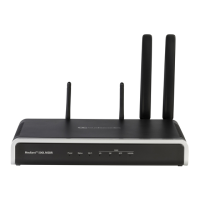User's Manual 890 Document #: LTRT-10466
Mediant 500L MSBR
Parameter Description
EMS: Dynamic Jitter Buffer
Minimal Delay (dB)
CLI: jitter-buffer-minimum-delay
[FaxModemBypasDJBufMinDela
y]
Defines the Jitter Buffer delay (in milliseconds) during fax and
modem bypass session.
The range is 0 to 150 msec. The default is 40.
EMS: Enable Inband Network
Detection
CLI: enable-fax-modem-inband-
network-detection
[EnableFaxModemInbandNetwor
kDetection]
Enables in-band network detection related to fax/modem.
[0] = (Default) Disable.
[1] = Enable. When this parameter is enabled on Bypass
and transparent with events mode (VxxTransportType is set
to 2 or 3), a detection of an Answer Tone from the network
triggers a switch to bypass mode in addition to the local
Fax/Modem tone detections. However, only a high bit-rate
coder voice session effectively detects the Answer Tone sent
by a remote endpoint. This can be useful when, for example,
the payload of voice and bypass is the same, allowing the
originator to switch to bypass mode as well.
EMS: NSE Mode
CLI: NSE-mode
[NSEMode]
Global parameter that enables Cisco's compatible fax and
modem bypass mode, Named Signaling Event (NSE) packets.
You can also configure this functionality per specific calls, using
IP Profiles (IpProfile_NSEMode). For a detailed description of
this parameter and for configuring this functionality in the IP
Profile table, see ''Configuring IP Profiles'' on page 332.
Note: If this functionality is configured for a specific IP Profile,
the settings of this global parameter is ignored for calls
associated with the IP Profile.
EMS: NSE Payload Type
CLI: NSE-payload-type
[NSEPayloadType]
Defines the NSE payload type for Cisco Bypass compatible
mode.
The valid range is 96-127. The default is 105.
Note: Cisco gateways usually use NSE payload type of 100.
EMS: T38 Use RTP Port
[T38UseRTPPort]
Defines the port (with relation to RTP port) for sending and
receiving T.38 packets.
[0] = (Default) Use the RTP port +2 to send/receive T.38
packets.
[1] = Use the same port as the RTP port to send/receive
T.38 packets.
Notes:
For this parameter to take effect, you must reset the device.
When the device is configured to use V.152 to negotiate
audio and T.38 coders, the UDP port published in SDP for
RTP and for T38 must be different. Therefore, set the
T38UseRTPPort parameter to 0.
Web/EMS: T.38 Max Datagram
Size
CLI: t38-mx-datagram-sz
[T38MaxDatagramSize]
Defines the maximum size of a T.38 datagram that the device
can receive. This value is included in the outgoing SDP when
T.38 is used.
The valid range is 120 to 600. The default is 560.
Web/EMS: T38 Fax Max Buffer
CLI: t38-fax-mx-buff
[T38FaxMaxBufferSize]
Defines the maximum size (in bytes) of the device's T.38 buffer.
This value is included in the outgoing SDP when T.38 is used
for fax relay over IP.
The valid range is 500 to 3000. The default is 3000.
Web: Detect Fax on Answer Tone
Determines when the device initiates a T.38 session for fax

